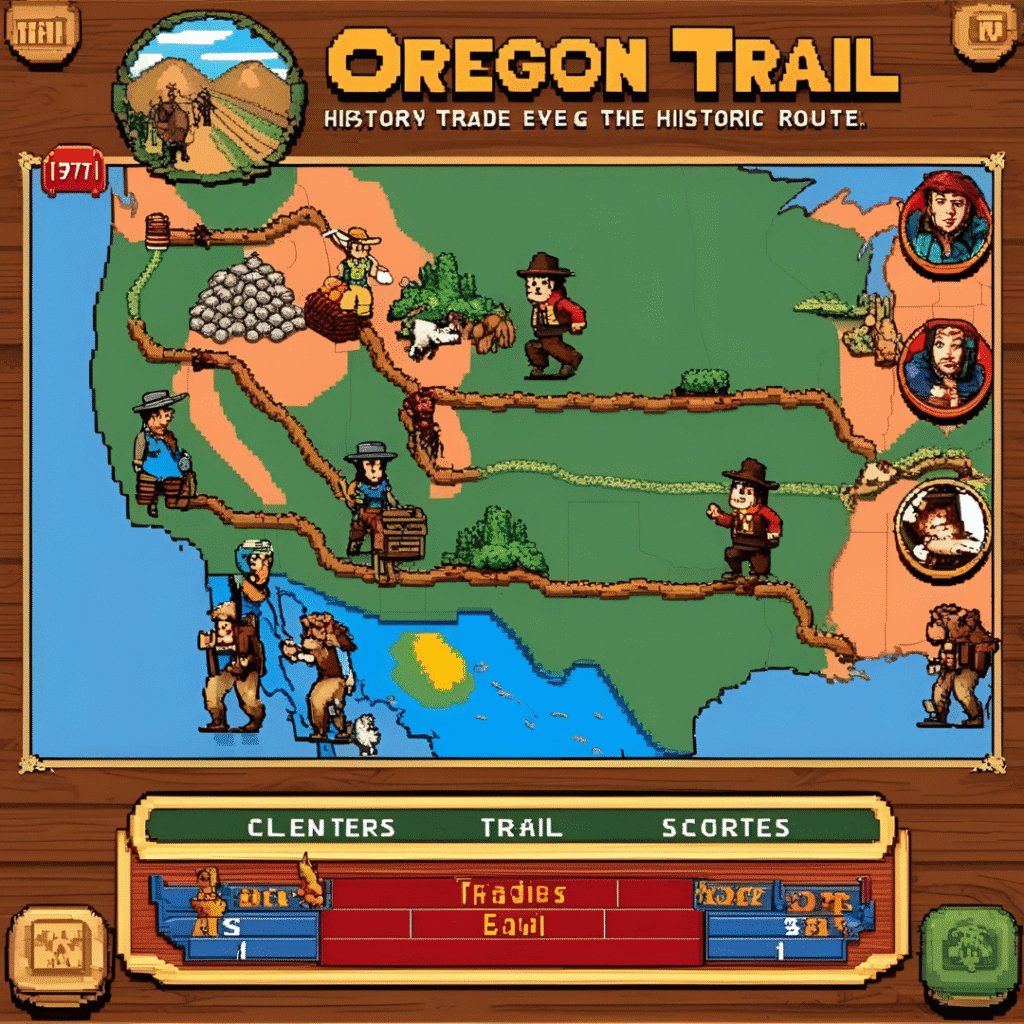The Oregon Trail (1971) – The Game That Made Learning Fun

When people talk about legendary video games, they often mention titles like Super Mario, Tetris, or Doom. But there’s one game that quietly left an enormous impact, not just on gaming, but on education and childhood memories for millions of people — The Oregon Trail.
First created in 1971, this humble text-based game began as an educational tool and ended up becoming a cultural icon. It wasn’t flashy, it didn’t have explosions or killer graphics, but it stuck with people. Whether you were trying to cross a river, hunt for food, or avoid dying of dysentery (yes, really), The Oregon Trail made learning fun — often without you even realizing it.
🌾 Where It All Began
The story of The Oregon Trail starts in Minnesota, in 1971. A young student teacher named Don Rawitsch had an idea to help his 8th-grade class understand what life was like for 19th-century pioneers. He wanted something more interactive than just reading from a textbook.
Together with his roommates Bill Heinemann and Paul Dillenberger, both fellow student teachers and computer enthusiasts, they wrote the game on a mainframe computer called the HP 2100. The game was text-based and had students make decisions just like real pioneers heading west in the 1800s. It was simple, but the idea was golden.
At first, the game was just for Don’s class, but it was such a hit that he brought it to the Minnesota Educational Computing Consortium (MECC), where it became part of a wider push to bring technology into schools.
💻 The Game Hits the Classroom
In the late ’70s and early ’80s, MECC began distributing The Oregon Trail to schools across the U.S., especially on early Apple computers like the Apple II. That’s when the game really blew up.
Students would rush to the school computer lab just to play it. They learned about supply management, critical thinking, and American history — all while trying not to die from typhoid, snakebites, or drowning in a river.
It wasn’t just a game; it was edutainment before that term even existed. The balance of history, decision-making, and just enough excitement made it timeless.
🐂 How the Game Worked
You played as the leader of a wagon party heading west from Independence, Missouri to Oregon’s Willamette Valley. The goal? Survive the journey.
You’d start by choosing your profession — banker, carpenter, or farmer. Each came with its own perks and money limitations. Then came shopping: buying food, oxen, ammunition, clothing, and spare parts.
As you traveled the trail, you’d face choices:
- Do you ford the river or try to float across?
- Do you rest when someone gets sick or push forward?
- Do you hunt for food or trade with others?
The game was partly strategy, partly luck. And it threw unexpected events at you:
- “You have died of dysentery.”
- “Your wagon wheel is broken.”
- “One of your oxen has drowned.”
It wasn’t fancy, but it felt real. Players were emotionally invested. Every time you lost a member of your wagon party, it hit you. And every time you made it to Oregon, it felt like a huge victory.
🎯 Educational Impact
The Oregon Trail was more than just a clever game. It was a revolution in educational technology. It taught kids how to:
- Budget resources
- Solve problems
- Deal with setbacks
- Understand historical context
Most importantly, it taught these things in a way that stuck. Kids who played it could remember facts about westward expansion far better than those who just read a textbook.
By the 1980s and 1990s, the game had been installed in tens of thousands of schools across the U.S. It became part of the classroom experience for an entire generation.
🧠 Cultural Legacy
The Oregon Trail’s influence didn’t stop in schools. It became a part of pop culture. The phrase “You have died of dysentery” became a meme long before memes were a thing.
Over the years, it inspired parodies, board games, t-shirts, and even mobile app versions. There’s a nostalgia attached to it that’s hard to explain to anyone who didn’t grow up with it.
It also paved the way for future educational games. It proved that learning and fun weren’t opposites — they could actually go hand in hand. Developers and educators saw what was possible.
🎮 Versions and Reboots
Since 1971, The Oregon Trail has gone through many versions:
- 1985 Apple II version – the most famous one, with pixel graphics and hunting mini-games.
- 1990s DOS and Windows versions – with better visuals and sound.
- Mobile apps (2010s) – reimagined versions for iOS and Android.
- 2021 remake by Gameloft – a modern version with updated visuals and more historically accurate elements.
Each version kept the core idea alive: making tough decisions on a long, dangerous journey west.
🤔 Why It Still Matters
Even now, decades later, The Oregon Trail holds a special place in gaming and education history. It’s a reminder that games can teach, that simple ideas can last, and that sometimes, the best learning happens when you’re having fun.
It also sparked a love for simulation and strategy games for many kids. For some, it was their first experience with computers, and for others, it inspired careers in history, tech, or teaching.
In a world full of complex graphics and intense gameplay, The Oregon Trail reminds us that sometimes, all you need is a good idea, some clever writing, and a little imagination.
🎬 Final Thoughts
The Oregon Trail wasn’t just a game; it was an experience, an educational milestone, and for many, a childhood rite of passage. It made you laugh, stressed you out, and taught you real lessons about survival, planning, and perseverance — all in the guise of a pixelated journey west.
It wasn’t easy. You lost people. You broke wagon wheels. You got lost. You probably died of dysentery at least once.
But you also learned. And maybe, just maybe, you made it all the way to Oregon.
And that’s why The Oregon Trail is still remembered more than 50 years later.




